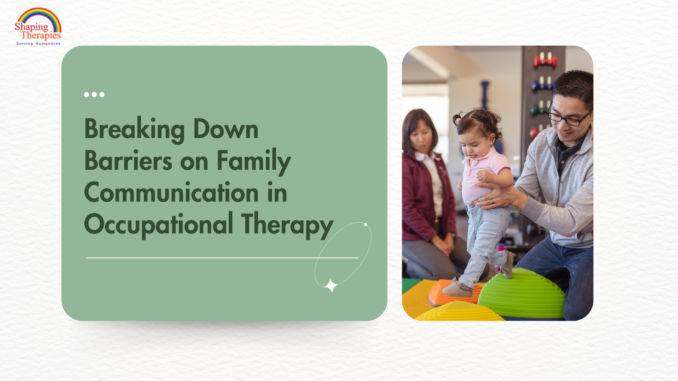
Introduction
Family communication plays a crucial role in the success of Occupational Therapy. When families and therapists work together effectively, the therapy process becomes more impactful and personalized. However, barriers such as misunderstandings, emotional stress, and language differences can hinder this collaboration, affecting the progress of therapy.
This blog explores the importance of family communication in Occupational therapy, identifies common challenges, and highlights strategies to overcome them. At Shaping Therapies, Thane, fostering a collaborative and supportive environment is key to achieving the best therapy outcomes for families and individuals.
Understanding Family Dynamics
Family dynamics significantly influence how communication unfolds during the Occupational therapy process. The interaction between family members, their roles, and their emotional bonds can either enhance or complicate therapy sessions.
- Role of Family Members: Each family member brings unique perspectives, which can help therapists understand the patient better. Active family involvement ensures therapy goals align with the child’s or individual’s daily life.
- Diverse Family Structures: Modern families come in various forms, including nuclear, joint, and single-parent setups. Therapists must respect and understand these diverse structures to ensure inclusivity.
- Cultural Backgrounds: Cultural beliefs often dictate how families approach therapy. Recognizing and addressing these differences is critical for building trust and improving communication.
Common Barriers to Effective Communication
Several obstacles can hinder effective communication in occupational therapy. Understanding these challenges is the first step toward addressing them.
| Barrier | Explanation |
| Language Differences | Families and therapists may face difficulties if they don’t share a common language. |
| Emotional Stress | Parents might feel overwhelmed, affecting their ability to engage in therapy discussions. |
| Misunderstanding Goals | Families may not fully grasp the purpose of certain therapy techniques or exercises. |
| Time Constraints | Busy schedules can limit communication opportunities between therapists and families. |
These barriers, if not addressed, can lead to confusion, reduced therapy effectiveness, and frustration for both families and therapists.
The Role of Occupational Therapists at Shaping Therapies, Thane
At Shaping Therapies, Thane, our Occupational therapists play an active role in breaking down communication barriers to ensure families are part of the therapy journey.
- Building Rapport: Establishing trust with families creates a foundation for open dialogue. Therapists invest time in understanding each family’s unique needs and concerns.
- Facilitating Collaboration: Therapists encourage family members to share their perspectives and actively participate in therapy planning.
- Enhancing Communication Skills: By using clear, jargon-free language and demonstrating empathy, therapists ensure families feel heard and understood.
Strategies for Improving Communication
Breaking down communication barriers requires a proactive approach. Here are some strategies that therapists and families can adopt:
- Active Listening: Pay full attention during conversations and acknowledge family concerns.
- Use of Clear Language: Avoid medical jargon and explain therapy goals and techniques in simple terms.
- Regular Feedback: Provide consistent updates on progress to keep families informed and involved.
- Family Involvement: Encourage families to ask questions, share observations, and suggest adjustments to therapy plans.
- Open Dialogue: Create a safe space for families to express doubts or emotions without fear of judgment.
Creating a Supportive Environment
A welcoming and inclusive atmosphere can make a world of difference in family communication. At Shaping Therapies, Thane, empathy and understanding are core principles.
- Welcoming Environment: From the moment families walk into the best occupational therapy centre in Thane, they should feel supported and valued.
- Empathy in Sessions: Therapists practice active empathy, recognizing the emotional journey families often go through.
- Inclusive Strategies: Tailor communication techniques to suit the family’s preferences and cultural norms
Case Studies and Success Stories
At Shaping Therapies, Thane, we’ve seen firsthand how improved communication leads to remarkable results.
- Case Study: A child with sensory processing challenges made significant progress when therapists and parents implemented a joint strategy based on clear communication and mutual understanding.
- Testimonial: “The therapists involved us in every step of the process. It felt like a partnership, and we saw tremendous growth in our child,” shares a happy parent.
These examples highlight the transformative power of breaking communication barriers.
Training and Resources for Occupational Therapists
Continuous professional development is essential for therapists aiming to improve family communication.
- Workshops: Regular sessions on cultural competence and communication techniques.
- Online Courses: Accessible training on new communication tools and strategies.
- Literature: Books and research papers on family dynamics and therapy communication.
By investing in training, therapists can stay updated and provide the best possible care.
Conclusion
Effective family communication is a cornerstone of successful Occupational Therapy. By addressing barriers, utilizing strategies, and creating a supportive environment, therapists can foster stronger relationships with families.
At Shaping Therapies, Thane, we are committed to breaking down barriers and delivering exceptional care. If you’re searching for the best Occupational therapy centre in Thane or an Occupational therapist near me, we are here to support your journey toward better communication and successful therapy outcomes.

Leave a Reply